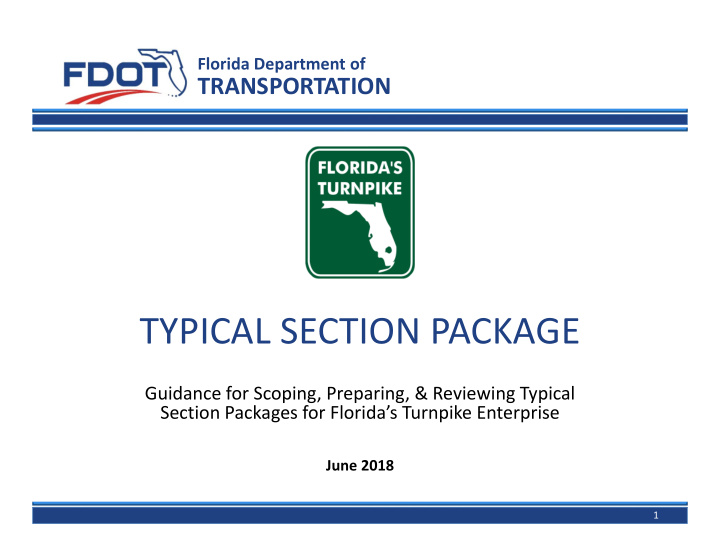



Florida Department of TRANSPORTATION TYPICAL SECTION PACKAGE Guidance for Scoping, Preparing, & Reviewing Typical Section Packages for Florida’s Turnpike Enterprise June 2018 1
Purpose 2018 FDOT Design Manual (FDM) – Section 120.2.3 • The purpose of the typical section package is to establish and document the following: o Project Controls o Cross Sectional Elements o Design Variations and Design Exceptions • Prepare a typical section package for projects that alter cross section elements and for resurfacing projects. • The typical section package must be prepared and sealed by the EOR. Florida Department of Transportation 2
Approval Process 2018 FDOT Design Manual (FDM) – Section 120.2.3.1 • PD&E o Preparation & coordination prior to the preferred alternative selection o Approval signatures after the preferred alternative selected • No PD&E o Preparation & coordination completed during initial engineering process (FDM 110) o Approval signatures prior to the final engineering process (FDM 111) 2018 Turnpike Design Handbook (TDH) ‐ Section 120.2.3.1 • Additional information when typical sections involve other agencies Florida Department of Transportation 3
What Warrants a Section 2018 FDOT Design Manual (FDM) – Section 120.2.3.3 • Roadway and bridges for project limits that include: o A Change in the number of through lanes. o A change in Project Controls; Functional Class, Context Class, Design Speed o Change in facility type; e.g. flush shoulder roadway to curbed roadway o A crossroad which may affect an existing structure • Intersecting roadways when work of significant length is required • Each proposed electronic toll point on toll facilities 2018 Turnpike Design Handbook (TDH) ‐ Section 120.2.3.1 • Realigned local roads, frontage roads, cul‐de‐sacs, railroads, canals, aerial transmission lines, or other facilities that impact the typical section Florida Department of Transportation 4
What Does NOT Warrant a Section • Changes in traffic lanes such as turn lanes and auxiliary lanes • Changes in construction type – new construction, widening w/ milling & resurfacing, milling & resurfacing • Changes in end condition type – shoulder gutter w/ guardrail, barrier wall, traffic railing on retaining wall • Transitions between typical sections • Temporary MOT conditions – roadway and bridges • Direction of traffic for ramps • Short roadway and bridge sections that are non‐typical • Changes in pavement designs Florida Department of Transportation 5
What Information is Required 2018 FDOT Design Manual (FDM) – Section 120.2.3.3 2018 Turnpike Design Handbook (TDH) ‐ Section 120.2.3.3 • All required information is available during the PD&E and the Initial Engineering Process. • Major elements include: o Project Controls – Context Classification, Functional Classification, Highway System, and Access Classification o Design Criteria – Indicate the type of construction o Anticipated Design Variations and Exceptions related to typical section o Traffic Data o Roadway and Bridge Cross Sectional Elements – R/W, Border, Lanes, Shoulders, Express Lane Buffer, Cross Slopes, Curb & Gutter, Barriers, Median, Front/Back Slopes, Ditches, Sidewalks/Shared Used Paths, Minimum Horizontal/Vertical Clearance, Toll Equipment Building/Gantries, etc. Florida Department of Transportation 6
What Information is NOT Required • Construction labels/info such as (but not limited to): standard clearing & grubbing, saw cut, widening, milling & resurfacing, friction course, sod, fence, limits of construction, etc. • Directions to the contractor such as (but not limited to): “Existing”, “To Remain”, “To Be Removed”, “Proposed”, “Construct”, “Install”, “Replace”, etc. • Defining the various roadside end condition such as (but not limited to): shoulder gutter w/ guardrail, shoulder barrier, traffic railing on retaining wall, superelevated roadway sections, traffic lanes (turn lanes/aux. lanes), etc. • Duplicating typical section information such as showing the mainline typical section along with the ramp typical section when the mainline is defined elsewhere or providing multiple ramp typical sections for each interchange quadrant Florida Department of Transportation 7
Scoping, Preparing & Reviewing Tips • Only scope and prepare typical sections required by the FDM and TDH • Only include the information required by the FDM and TDH • Construction plans will have additional sections and details for the various construction activities and end conditions; do not include these in the Typical Section Package • Avoid duplicating typical section information • Avoid construction labels, information, and directions to the contractor • If the information is not available during the PD&E or the Initial Engineering Process then it does not belong in Typical Section Package • Consultant EORs, QC Reviewers, and Department QA reviewers should not request typical sections that are not included in the scope or request information be added that is not required by the FDM and TDH Florida Department of Transportation 8
Recommend
More recommend